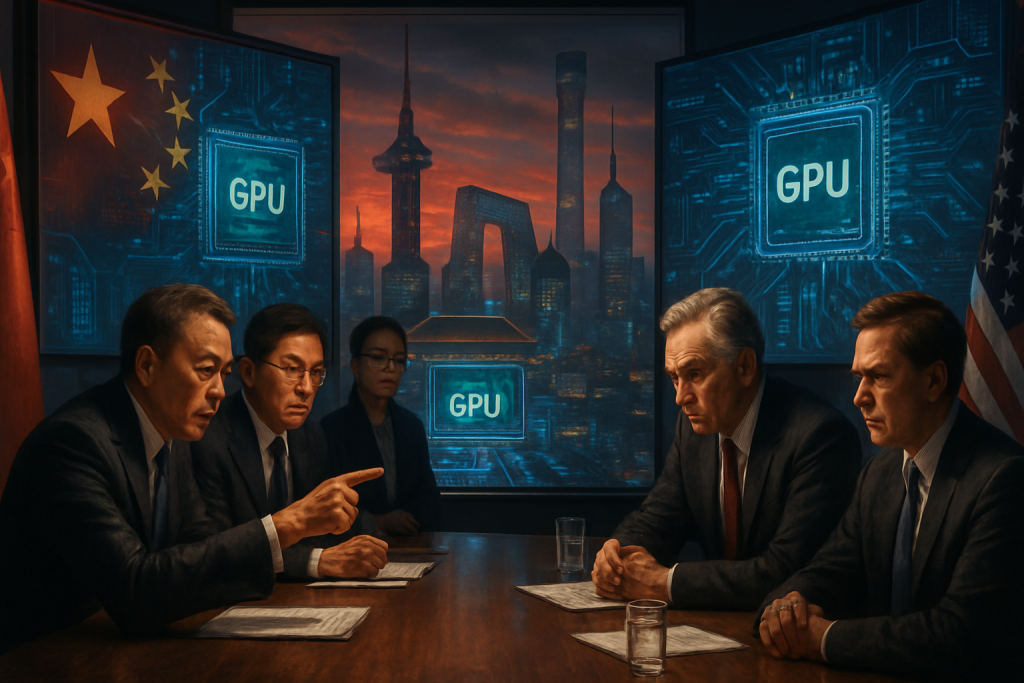The year is 2025. Self-driving cars are (mostly) a thing. AI-generated art is winning awards (and sparking endless debates about what constitutes “art”). And Nvidia, the company that’s been quietly fueling the AI revolution from behind the scenes, is now a four-trillion-dollar behemoth. But as Spiderman’s Uncle Ben famously said, “With great power comes great responsibility” and, in Nvidia’s case, a whole lot of geopolitical complexity. This week, that complexity takes center stage as CEO Jensen Huang heads to Beijing for a media briefing on July 16th, his second trip to China this year.
Why does this matter? Well, China is a massive market for Nvidia. In the last fiscal year, it accounted for a whopping 13% of their total revenue, translating to around $17 billion. That’s a lot of GPUs. It’s enough to make any CEO hop on a plane, even if that plane is flying into the heart of a brewing tech cold war.
Huang’s visit arrives at a particularly sensitive time. The U.S. government, increasingly wary of China’s technological advancements (and potential military applications), has slapped restrictions on the export of Nvidia’s most advanced chips to the country. Think of it like trying to sell the Batmobile to Lex Luthor. Not a great idea. Even the H20 AI chips, initially approved for export to China, have now been caught in the crossfire and banned. The rationale? National security, of course. The fear is that these powerful chips could be used to train AI models that could, in turn, be used for nefarious purposes. It’s a classic “dual-use” dilemma, straight out of a Philip K. Dick novel.
The political pressure is intense. U.S. senators are reportedly urging Huang to steer clear of any dealings with companies linked to the Chinese military or intelligence agencies, or those that have found themselves on the government’s naughty list of restricted exporters. It’s a high-stakes game of geopolitical chess, and Huang is walking a tightrope.
But why the fuss over Nvidia chips in the first place? The answer lies in their architectural dominance. Nvidia’s CUDA platform has become the industry standard for accelerated computing, making their GPUs essential for training and running complex AI models. It’s like the Dolby system of the AI world. Everyone wants it, and it’s hard to replicate. Even with rising competition from domestic Chinese companies like Huawei, Nvidia maintains a significant edge, thanks to its established ecosystem and the sheer power of its hardware.
So, what’s at stake here? Let’s break it down:
For Nvidia, the stakes are clear: maintaining access to a crucial market while navigating the treacherous waters of U.S.-China relations. Losing access to the Chinese market would be a significant blow, potentially impacting their revenue and future growth prospects. Imagine Apple being barred from selling iPhones in China. It would be catastrophic. For Nvidia, the impact wouldn’t be quite as severe, but it would still sting.
For China, the stakes are about technological self-sufficiency. The U.S. restrictions are forcing China to accelerate its efforts to develop its own domestic AI chip industry. This could lead to increased competition and innovation in the long run, but in the short term, it creates a bottleneck for Chinese companies that rely on Nvidia’s hardware. They’re essentially being forced to build their own Death Star, and it’s not going to be easy.
For the U.S., the stakes are about maintaining its technological lead in AI. The restrictions are intended to prevent China from gaining an unfair advantage in this critical field. However, some argue that these restrictions could backfire, hindering U.S. companies’ ability to compete globally and potentially stifling innovation. It’s a gamble, and the outcome is far from certain.
The philosophical questions lurking beneath the surface are even more profound. Are we entering an era of technological balkanization, where different countries and regions develop their own separate AI ecosystems? Will this lead to fragmentation and a slowdown in overall progress? And what are the ethical implications of restricting access to AI technology? Are we denying developing countries the opportunity to benefit from AI’s potential to solve some of their most pressing challenges? It’s a complex web of interconnected issues with no easy answers.
Financially, the ripples are already being felt. Nvidia’s stock price has been volatile, reacting to every twist and turn in the U.S.-China tech saga. Companies that rely on Nvidia’s chips are also feeling the pinch, as they scramble to find alternative solutions. And the broader market is watching closely, wondering whether this is just the beginning of a more widespread decoupling of the U.S. and Chinese tech industries. It’s like watching a slow-motion train wreck, except the trains are carrying billions of dollars and the future of AI.
As Jensen Huang steps up to the podium in Beijing, the world will be watching. His words, his actions, and his very presence will send a powerful message about Nvidia’s commitment to the Chinese market and its ability to navigate the increasingly complex geopolitical landscape. It’s a scene worthy of a spy thriller, and the stakes couldn’t be higher.
Discover more from Just Buzz
Subscribe to get the latest posts sent to your email.


